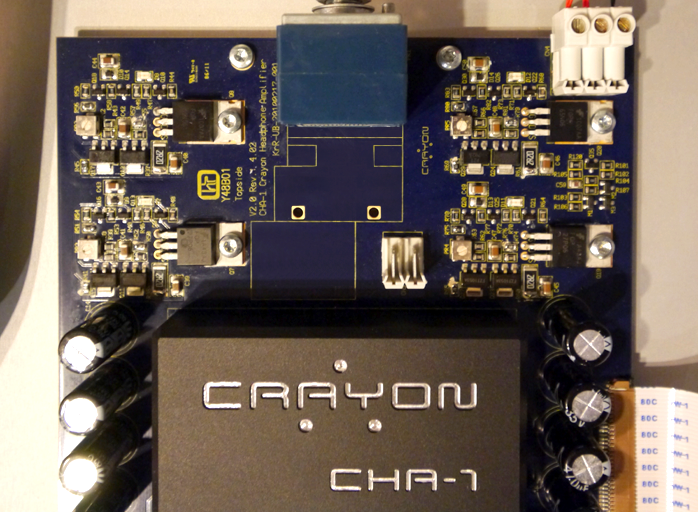This review page is supported in part by the sponsors whose ad banners are displayed below |
 |
 |
"Our output stage is a true integrated wideband 300mA video amplifier
that's heat-sinked and shielded by the aluminium casing. As a current-feedback op amp, typical values for this output driver are 3nV noise and 90MHz bandwidth into 100Ω with a 1'300V/μs slew rate and 8Vpp swing potential. Current feedback creates great stability into highly capacitive or complex loads. Speed/bandwidth make for ultra-low distortion and a -120dB noise floor."
|
 |
Wall power phase detection circuit top left, main ±24V/400mA supply as the two big Mornsun units, standby supply as the small Mornsun unit
|
Bad dog. As it turned out, all of this was still a prelude of things to come. Enter Fred Crane and his desire to also drive his Stax and TakeT H2+ electrostats and piezo AMT from the same amp. Roland's response? A special version he hopes to have ready by April. Things were about to get badder yet. "For this we'll use bridged outputs to double current for ideal 600Ω drive. This will deliver 450mA which to my mind is sufficient for all dynamic headphones.
A servo will create very low DC offset and won't effect bass performance. This I already verified with my AKG K1000 whose bass is very good, dry and powerful. We'll integrate a high-voltage amplifier to drive electrostatic loads like Stax and TakeT. We can configure this module for either 80V or 200V to be fixed at order time. To accommodate those types of 'phones, the 4-pin XLR will be swapped out for the necessary connector. The dual 3-pin and 6.3mm outputs will remain to drive all other headphones. The new output stage will be discrete class A and its high-voltage regulated switching supply will run at 400kHz to cancel 115/230V concerns. The existing Mosfets generate sufficient gain to require no additional active parts. Supply ripple suppression will be better than 1mV.
Over the normal version, power delivery at RMS and peak will scale up to 4.3/6 watts into 30Ω, 7.6/10 watts into 50Ω, 2.4/4.8 watts into 150Ω, 1.2/2.4 watts into 300Ω and 0.6/1.2 watts into 600Ω. Because a 6.3mm port cannot be connected to a bridged output stage, its power values remain unchanged. The higher power values will only appear at the XLR and custom ports. Max power consumption will be 55 watts."
|
|
|
Leash time. "I should now mention the ongoing exchanges I had with Fred about my refusal to practice material excess. I always endeavor to use normal parts. I reject €500 caps or €1'000 transformers. My competence is advanced circuit design. This reflects ~80% proprietary solutions unrelated to common standards. Of course certain parts make no sense to reverse engineer. Then I rely on pre-existing ones.
But all of it reflects much time and money and endless prototyping to develop new and better solutions. Four years ago I dreamt of designing an ultimate headphone amp. Market response to the notion at the time was zero except for Asia. So I designed the CHA-1 for myself. Today even our German dealers acknowledge that the headfi boom is real. My dream was to
sell perhaps 50 units over a 5-year stretch. That type of low-volume production creates very high per-unit costs. For just one example, 100 boards for the CFA-1.2 cost us three times less per unit than just two boards for the CHA-1. At lots of 100 we could make and sell the CHA-1 for considerably less. Such are the realities for extremist specialty hifi.
|
 |
"Add assembly, chassis, knobs and sundry bits and let's just say that profitability even for the CFA-1.2 only kicks in after 317 units have sold. I'm highly doubtful there's a market for the CHA-1 to sell in such numbers. I'm always worried when pricing doesn't reflect visual bling. Chances are people won't give you a chance just to audition your creations. This barrier is purely conceptual. The core fact is very basic. Even so it's beyond the average consumer. Whilst advanced R&D and IP might be more intangible than overrated boutique parts which merely hide the nth iteration of an old circuit, they ought to be valued far more. It's not costly parts which produce results. It's advanced circuit design. But that's not sexy, is it?"
|
|
|
|
| Retailers too rely on sex to sell. "Fred wants something different than the current Alps. Whilst I don't believe
that anyone could hear any spatial deviations caused by the
constant velocity of a pot, we'll fulfill his wish. Concerns of retail partners are valid. The new part connects by ribbon cable to enable more expensive rotary switches. The final case does away with the current front-panel fixing blocks. The fascia now bolts directly to the bottom plate. For the special version pricing remains TBD. There's also a chassis without top discs again by request from Fred. You still see no bolts as they now come through the bottom." |
|
|
|
 |
Prélude in C minor by Crayon. Since I'd already committed to a review of the TakeT H2+ with Trafomatic Audio's custom amp for it, Roland wondered whether I should even bother with the 'basic' version. I suggested that it'd make for a terrific introduction to the CHA-1 concept as this iteration should satisfy the vast majority of prospective users. I'd thus cover its sonics on conventional dynamic loads. When the special version with its built-in high-voltage module and bridged high-power outputs bowed to accommodate the 7KΩ H2+ and truly power-hungry dynamics, I'd append those results in a subsequent page or two. If this multi-stage approach affords us a behind-the-scenes glance at a product's final stretch to the production finish line, why not. Roland was game and this game was on.
|
 |
  |
 |